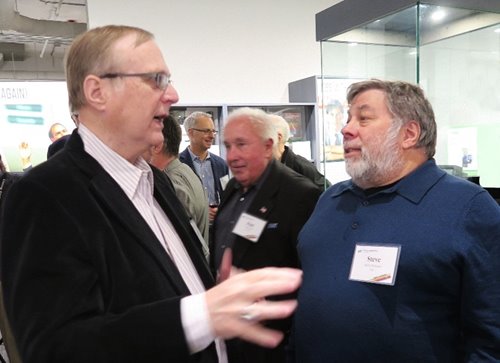By Erin M.
[Read part 1 of our Profiles in Computing: Steve Wozniak]
The Apple II was a wildly successful computer that’s still remembered fondly today. Released in 1977, it was the first microcomputer to generate color graphics and have BASIC pre-loaded. It had eight expansion slots, an upgrade from the Apple 1 which provided none. Woz and Jobs debuted the computer at the West Coast Computer Faire in the same year. Initially it included a cassette tape drive but Woz eventually designed the Disk II floppy disk drive, made available in 1978 and created specifically for the Apple II. After a couple of years of whirlwind success, Apple went public in 1980, making both Woz and Jobs instant millionaires. But success isn’t always guaranteed, and that same year Apple released the follow up to the superstar Apple II with the Apple III, a tremendous flop for the company which was discontinued shortly after in 1984. There were many problems with the Apple III, most stemming from the fact that the marketing department instead of the engineering department at Apple had too much influence over the design. Woz is famously quoted explaining that the Apple III suffered from “100 percent hardware failures.”
More setbacks would continue for Wozniak. In February 1981, Wozniak was in a small plane crash. As the pilot, Woz was flying his new girlfriend, Candice Clark, her brother, and his girlfriend in a Beechcraft Bonanza A36TC. They took off from Sky Park Airport in Scotts Valley, California. During takeoff the plane stalled, bounced down the runway, barreled through two fences and finally crashed into a nearby embankment. Luckily no one died in the crash but all four suffered injuries. Woz suffered head injuries, facial injuries, and lost a tooth. He also suffered from anterograde amnesia after the crash. This stopped him from making new memories for a period. When he woke up in the hospital, he did not remember the crash or his own name. An investigation into the crash by the National Transportation Safety Board found that pilot inexperience was the cause of the accident. Following the crash, Woz decided to resign from Apple. He recovered over time and credits playing games on the Apple II computer as helping him to regain his memory. But his love for computing and engineering had suffered and his interests had changed.
After Woz recovered from his plane crash he reenrolled in the University of California, Berkley to finish his degree. By this time, he was a well-known computer pioneer, so he reenrolled in school as Rocky Raccoon Clark to avoid making a scene. It was the name eventually written on his diploma, which he didn’t receive until 1987, a decade after the release of the Apple II.
Wozniak also organized a short-lived music festival in his time away from Apple. With the help of Bill Graham, member of the radical and infamous San Francisco Mime Troupe, and one of the most successful concert promoters of the 1960s Haight-Ashbury music scene, Wozniak organized the US Festival. The festival was held just east of Los Angeles in San Bernardino, California. Pronounced as “
us,” the pronoun, it was meant to be a festival that celebrated music as well as emerging technology and computer science. The first annual festival happened in May of 1982. After spending 12 million dollars on the first festival, Woz decided that if the second annual US Festival failed to make money again, he would go back to working with computers. After the second annual festival resulted in the same financial flop as the first, Woz went back to designing computers for Apple once more.
 (Paul Allen and Steve Wozniak at the opening of the Apple exhibit at Living Computers: Museum + Labs, 2017)
(Paul Allen and Steve Wozniak at the opening of the Apple exhibit at Living Computers: Museum + Labs, 2017)
Woz returned to Apple, but not for long. His final new design for the company was the Apple Desktop Bus, a proprietary bit-serial peripheral, introduced on the Apple IIGS. It was a low-cost way to daisy chain keyboards and mice without other devices. Used on all subsequent Macintosh computers and eventually NeXTcube computers, it would be replaced with the USB port in later years. But even after this personal success Woz was unhappy at Apple. He resented how the Apple II team was treated, even though Apple II computers were making the company most of its money. In 1985, at an Apple Shareholder’s meeting, the Apple II team wasn’t even mentioned, even though they made up 85% of the company’s financial earnings that year. The culture at Apple inspired Woz to quit the company he had started only 10 years earlier and this time for good.
Wozniak has been a major figure in computer science, technology, philanthropy, and pop culture ever since. He is still technically an Apple employee and customer and was recently a public critic of the company’s new credit card limits for women. Steve Wozniak--or Wizard of Zeus or Rocky Raccoon Clark--is the epitome of the hacker spirit from the 1970s. His humbleness, sense of humor, and willingness to break the rules for fun helped create the spirit of Apple. Apple was the first ever trillion-dollar publicly traded company in no small part thanks to the forward thinking and clever designs that Woz created. As the field of computer science and technology becomes more corporate, more competitive, and more rigid, computer pioneers like Steve Wozniak hold out hope for many of us, including myself, that computers are inherently fun and creative.